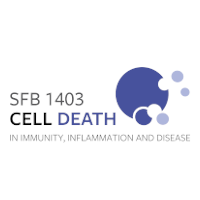Z-nucleic-acid sensing triggers ZBP1-dependent necroptosis and inflammation

Abstract:
The biological function of Z-DNA and Z-RNA, nucleic acid structures with a left-handed double helix, is poorly understood1,2,3. Z-DNA-binding protein 1 (ZBP1; also known as DAI or DLM-1) is a nucleic acid sensor that contains two Zα domains that bind Z-DNA4,5 and Z-RNA6,7,8. ZBP1 mediates host defence against some viruses6,7,9,10,11,12,13,14 by sensing viral nucleic acids6,7,10. RIPK1 deficiency, or mutation of its RIP homotypic interaction motif (RHIM), triggers ZBP1-dependent necroptosis and inflammation in mice15,16. However, the mechanisms that induce ZBP1 activation in the absence of viral infection remain unknown. Here we show that Zα-dependent sensing of endogenous ligands induces ZBP1-mediated perinatal lethality in mice expressing RIPK1 with mutated RHIM (Ripk1mR/mR), skin inflammation in mice with epidermis-specific RIPK1 deficiency (RIPK1E-KO) and colitis in mice with intestinal epithelial-specific FADD deficiency (FADDIEC-KO). Consistently, functional Zα domains were required for ZBP1-induced necroptosis in fibroblasts that were treated with caspase inhibitors or express RIPK1 with mutated RHIM. Inhibition of nuclear export triggered the Zα-dependent activation of RIPK3 in the nucleus resulting in cell death, which suggests that ZBP1 may recognize nuclear Z-form nucleic acids. We found that ZBP1 constitutively bound cellular double-stranded RNA in a Zα-dependent manner. Complementary reads derived from endogenous retroelements were detected in epidermal RNA, which suggests that double-stranded RNA derived from these retroelements may act as a Zα-domain ligand that triggers the activation of ZBP1. Collectively, our results provide evidence that the sensing of endogenous Z-form nucleic acids by ZBP1 triggers RIPK3-dependent necroptosis and inflammation, which could underlie the development of chronic inflammatory conditions—particularly in individuals with mutations in RIPK1 and CASP817,18,19,20.
Read more at: Nature https://doi.org/10.1038/s41586-020-2129-8
